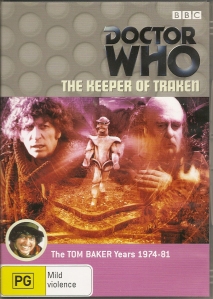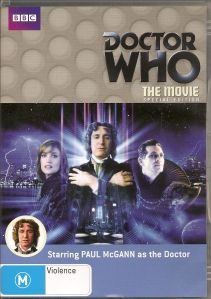N.B. The following written text in this blog-post Doctor Who and The Master’s Resurrection (Part Two) is Copyright © 2012 Philip Johnson.
For the first instalment Doctor Who and The Master’s Resurrection (Part One) click here.
A TIME LORD “GONE BAD”
 Last time we looked a little bit at the background to the character The Master. He is a renegade Time Lord and plays a recurring role throughout Doctor Who.
Last time we looked a little bit at the background to the character The Master. He is a renegade Time Lord and plays a recurring role throughout Doctor Who.
We found that just like Professor Moriarty’s role in Arthur Conan Doyle’s stories about Sherlock Holmes, so too The Master is the arch-nemesis of The Doctor. (There are other aspects to The Master’s character that will be explored in a separate post).
It is in the 1971 story Terror of the Autons that we first encounter The Master (played by Roger Delgado) during the life-span of the third Doctor (Jon Pertwee). At this stage in history The Doctor was exiled by the Time Lords to live on earth and they mentally blocked his memory of the dematerialisation codes for operating his TARDIS (time travel vessel). A Time Lord drops in unexpectedly to warn The Doctor that The Master is somewhere on the earth and is plotting to kill him.
The Master attempts to draw the Nestene consciousness (the basis of the alien creatures the Autons) toward earth using a radio telescope signal. He intends that through the Autons’ invasion that all humans will be destroyed. The Autons, which can incarnate as individual entities in plastic (such as shop-front mannequins), will transform all plastic products making them lethal to humans. Although The Master’s plan aborts he successfully evades capture by The Doctor and his friends from U.N.I.T. His escape signifies that he will return in a further attempt to carry out his plans to destroy The Doctor and humanity.
Third Doctor vs The Master
 During his exile The Doctor matches wits with The Master (as played by Roger Delgado) in these adventures: The Mind of Evil, The Claws of Axos, Colony in Space, The Dæmons, The Sea Devils and The Time Monster.
During his exile The Doctor matches wits with The Master (as played by Roger Delgado) in these adventures: The Mind of Evil, The Claws of Axos, Colony in Space, The Dæmons, The Sea Devils and The Time Monster.
With the exception of Colony in Space, all the adventures involve The Master taking action to subjugate the earth using aliens, or non-human terrestrial creatures as the vanguard for his grander schemes to either control or destroy humanity. Sometimes it also involves attempts to acquire powers (such as those held by Azal the Dæmon; the power of the “time-eating” entity Kronos) or ultimate weapons (the Doomsday weapon). The Doctor’s counter-actions invariably thwarts The Master.
At the closing of another adventure (not involving The Master), the Time Lords “pardon” The Doctor and release him from his sentence of earthly exile (see The Three Doctors).
In his post-exilic adventures, the third Doctor encounters The Master (Roger Delgado) once again in a titanic struggle in the twenty-sixth century (Frontier in Space). This story sadly became the final unexpected appearance of Roger Delgado as The Master because he died in 1973 in a car accident en route to a non-Doctor Who film location in Turkey.
In the 1970s Terrance Dicks (1935-) and Malcolm Hulke (1924-1979), who were both script-writers for Doctor Who, described The Master in these terms:
The Master is dedicatedly evil. He loves chaos and disaster for its own sake, will start a war for the sheer fun of it, and likes nothing better than to make a bad situation worse. His one ambition is to destroy the Doctor, who has foiled so many of his evil plans.
The fourth Doctor subsequently described The Master as “the quintessence of evil.” The Doctor recalls that “he was evil, cunning and resourceful” and was “consumed with hatred”.
Regeneration Cycles
In its format and structures Doctor Who offers some creative flexibility for the development, renewal and revision of ideas and themes. An example of this concerns Time Lord regeneration. In previous posts (see here, here and here) I have indicated that Time Lord regeneration offers an analogy for resurrection from the dead.
David Rafer notes that as a mythic hero figure The Doctor resonates at times with archetypes among which he is “also resurrected through Time Lord regeneration.” (“Mythic Identity in Doctor Who” in Time and Relative Dissertations In Space: Critical Perspectives on Doctor Who, ed. David Butler, Manchester: Manchester University Press, 2007, 125).
 From the TV-production side regeneration is a handy way of making explicable the visual transition from one actor to the next playing The Doctor. Yet within the internal history of the series, regeneration enables The Doctor to be fully rejuvenated and physically transformed by resurrection.
From the TV-production side regeneration is a handy way of making explicable the visual transition from one actor to the next playing The Doctor. Yet within the internal history of the series, regeneration enables The Doctor to be fully rejuvenated and physically transformed by resurrection.
However, what regeneration entails for Time Lords has been gradually revealed across the TV series. The second Doctor (played by Patrick Troughton) divulged to his companions Zoe and Jamie, “The Time Lords are an immensely civilised race. We control our own environment. We can live forever barring accidents and we have the secret of space-time travel.” (The War Games, episode 10). These remarks pointed in the direction that while Time Lords are mortal (“barring accidents”) the physical renewal of life for each individual Time Lord through the process of regeneration could continue in a virtually endless cycle of rejuvenation.
 An apparent revision of the second Doctor’s perspective comes in the adventures of the fourth Doctor (played by Tom Baker). In The Deadly Assassin it is indicated that a Time Lord can only regenerate twelve times after the first life-span: in other words, a Time Lord has a sum total of thirteen possible incarnations. (Whether this point about thirteen incarnations remains fixed or undergoes revision in future stories is unknown but quite plausible).
An apparent revision of the second Doctor’s perspective comes in the adventures of the fourth Doctor (played by Tom Baker). In The Deadly Assassin it is indicated that a Time Lord can only regenerate twelve times after the first life-span: in other words, a Time Lord has a sum total of thirteen possible incarnations. (Whether this point about thirteen incarnations remains fixed or undergoes revision in future stories is unknown but quite plausible).
It is in The Deadly Assassin that the fourth Doctor battles wits with The Master back on the Time Lord’s home planet of Gallifrey. In this story The Master is emaciated and decaying because he has reached the very end of his thirteenth incarnation but is seeking a way to cheat death.
At the climax of this story, The Master almost has within his grasp a source of cosmic power — the nucleus of a black hole — which he believes will give him “supreme power over the universe.” It is this same power that he hopes to convert into some kind of physical reconstitution and renewal.
However, in a physical tussle that parallels Sherlock Holmes wrestling Professor Moriarty on the Reichenbach Falls, The Master falls into a chasm. Although believed dead, the end of the story shows The Master has survived and he escapes Gallifrey. The Master’s emaciated face is slightly but not fully rejuvenated. So he has not experienced regeneration and so it is more a revivification than a resurrection in The Deadly Assassin. However, as we will see in the next post (part Three), The Master manages to cheat death several more times in future stories.
Stay tuned!









